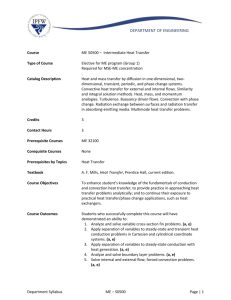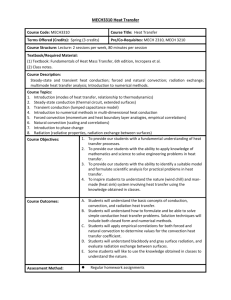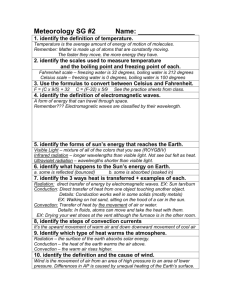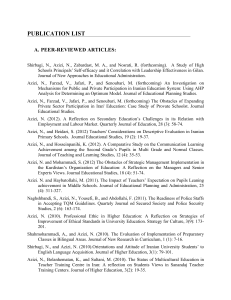Total Lecture Hours: 3 x 14 weeks - Faculty of Chemical & Natural
advertisement
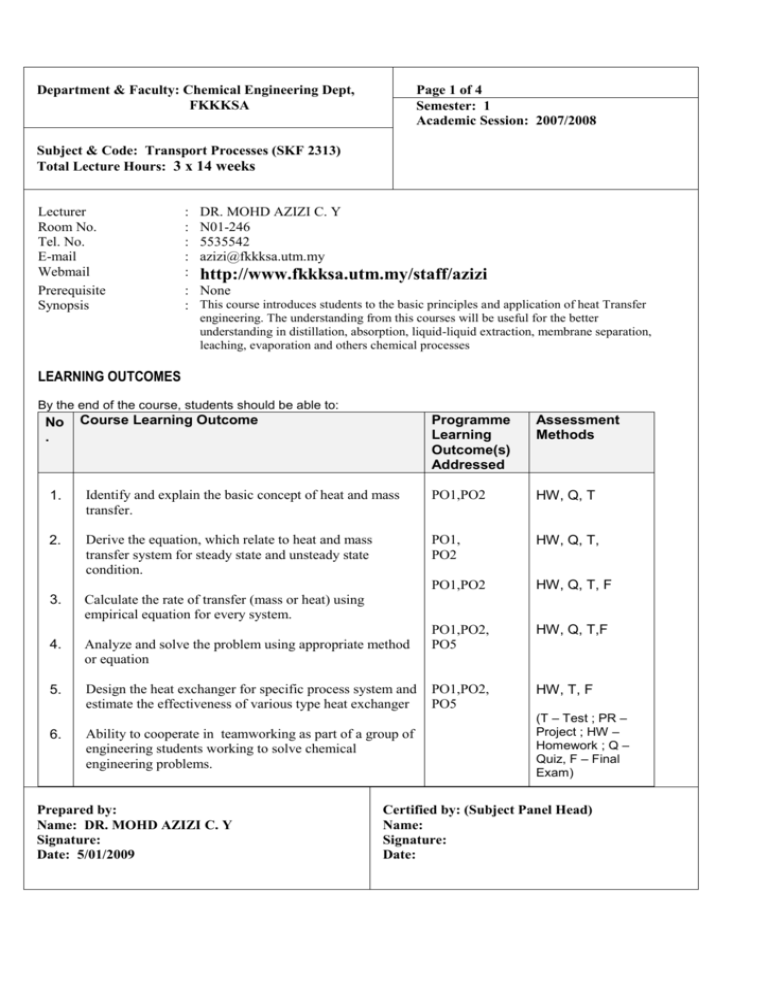
Department & Faculty: Chemical Engineering Dept, FKKKSA Page 1 of 4 Semester: 1 Academic Session: 2007/2008 Subject & Code: Transport Processes (SKF 2313) Total Lecture Hours: 3 x 14 weeks Lecturer Room No. Tel. No. E-mail Webmail Prerequisite Synopsis : : : : : : : DR. MOHD AZIZI C. Y N01-246 5535542 azizi@fkkksa.utm.my http://www.fkkksa.utm.my/staff/azizi None This course introduces students to the basic principles and application of heat Transfer engineering. The understanding from this courses will be useful for the better understanding in distillation, absorption, liquid-liquid extraction, membrane separation, leaching, evaporation and others chemical processes LEARNING OUTCOMES By the end of the course, students should be able to: No . Course Learning Outcome Programme Learning Outcome(s) Addressed Assessment Methods 1. Identify and explain the basic concept of heat and mass transfer. PO1,PO2 HW, Q, T 2. Derive the equation, which relate to heat and mass transfer system for steady state and unsteady state condition. PO1, PO2 HW, Q, T, PO1,PO2 HW, Q, T, F 3. Calculate the rate of transfer (mass or heat) using empirical equation for every system. Analyze and solve the problem using appropriate method or equation PO1,PO2, PO5 HW, Q, T,F 4. 5. Design the heat exchanger for specific process system and estimate the effectiveness of various type heat exchanger PO1,PO2, PO5 HW, T, F 6. Ability to cooperate in teamworking as part of a group of engineering students working to solve chemical engineering problems. Prepared by: Name: DR. MOHD AZIZI C. Y Signature: Date: 5/01/2009 (T – Test ; PR – Project ; HW – Homework ; Q – Quiz, F – Final Exam) Certified by: (Subject Panel Head) Name: Signature: Date: Department & Faculty: Chemical Engineering Dept, FKKKSA Page 2 of 5 Semester: 1 Academic Session: 2007/2008 Subject & Code: Transport Processes (SKF 2313) Total Lecture Hours: 3 x 14 weeks PROFESIONAL SKILL ADDRESSED : Problem Solving (CR1 –CR4) Lifelong Learning (LL1-LL3) Team working (TW1-TW5) STUDENT LEARNING TIME Teaching and Learning Activities Student Learning Time (hours) 1. Lecture 2. Independent Study - self learning - information search - library search - reading - group discussion 3. Assignment (5x) - self learning - group discussion 4. Test (2) And Quizzes 5. Exam (1x) 42 42 15 8 3 Total 110 TEACHING METHODOLOGY Lecture and Discussion, Active Learning, Independent Study, Group Project. Prepared by: Name: DR. MOHD AZIZI C. Y Signature: Date: 5/01/2009 Certified by: (Subject Panel Head) Name: Signature: Date: Department & Faculty: Chemical Engineering Dept, FKKKSA Page 3 of 5 Semester: 1 Academic Session: 2007/2008 Subject & Code: Transport Processes (SKF 2313) Total Lecture Hours: 3 x 14 weeks Week # 1 2&3 Topic Introduction to Transport Processes Type of Transport Processes Transport Analogy Electrical Analogy General Transport Equation for Momentum, Heat and Mass Transfer Heat Transfer : Conduction 4&5 Introduction to heat transfer Conduction - Fourrier’s law - Basic energy balance equation Steady state conduction through plate Steady State conduction in cylindrical system Steady state conduction in spherical system Conduction through material in parallel Conduction with internal heat generation Overall coefficient Extended surface or fins Heat Transfer: Convection 6&7 Learning Outcome Concept of boundary layer Forced convection Flow inside tube flow parallel to flat plate Flow perpendicular to horizontal cylinder Flow past single sphere Flow past banks of tubes Convection Free convection: Vertical planes or cylinder Horizontal cylinder Horizontal plate Boiling Condensation It is expected that students will be able to: Describe the basic equation of transport process Identify the rate, driving force and resistance for each type of transport processes Illustrate the transport system in form of electrical circuit. It is expected that students will be able to: Define the mechanism of heat transfer: conduction, convection and radiation Identify and recall basic energy balance equation for every coordinate. Derive the conduction equation for plate, cylindrical and spherical system and identify the resistance for each system. Calculate rate of heat transfer in various systems Estimate fine efficiency and calculate heat lost through fins. It is expected that students will be able to: Explain the differences between free and forced convection Define boundary layer, Dimensionless Number; Prantle and Nusselt Numbers. Apply the empirical equation to determine heat transfer coefficient. Calculate amount of heat transfer in the system. It is expected that students will be able to: Explain the principle of Boiling and condensation Estimate the heat transfer coefficient for free convection, boiling and condensation Calculate rate of vaporization and condensation Week # 8 9-10 Topic Heat Exchanger Introduction and Classification of heat exchanger Design procedure shell and tube heat exchanger LMTD method Heat exchanger effectiveness Radiation 11-12 Basic principle of radiation Nature of Radiant Heat Transfer Radiation from Black Bodies Radiation from Real Bodies Radiation to small object from surrounding Radiation between surface View factor MASS TRANSFER 13-14 Learning Outcome Basic principle of mass transfer Molecular diffusion Mass diffusion in gas phase Mass diffusion in liquid phase Mass diffusion through solid Convective mass transfer UNSTEADY STATE Unsteady state heat transfer - Lump capacitance method; based on heat balance for uniform temperature system - Graphical method: semi infinite solid, slab, cylindrical system and spherical system Unsteady state mass transfer - Graphical method: semi infinite solid, slab, cylindrical system and spherical system It is expected that students will be able to: Classify type of heat exchanger and explain the advantages and disadvantages Explain the step of design procedure Estimate temperature different, overall heat transfer coefficient, individual coefficient, and surface area required Estimate overall dimension of heat exchangers Calculate the effectiveness of heat exchanger It is expected that students will be able to: Explain the principle of radiation and related terminology is used Differentiate between black and gray body. Estimate heat transmit or absorb from surrounding Estimate view factor and solid angle between two surfaces Calculate the rate of heat transfer between two surface in various arrangement It is expected that students will be able to: Explain the principle of mass transfer and fick’s law Derive the equation for mass diffusion in gas, liquid and solid phase. Calculate the rate of mass transfer Apply the empirical equation to determine mass transfer coefficient. Calculate amount of mass transfer in the system. It is expected that students will be able to: Derive the energy balance equation for specific uniform temperature system Estimate the time required in heating or cooling of specific object. Determine temperature of the system via exposure time to the surrounding Calculate temperature or interval time of the heating or cooling system using graphical method. Calculate concentration or interval time of the mass diffusion system using graphical method. Page 5 of 5 Semester: 1 Academic Session: 2007/2008 Department & Faculty: Chemical Engineering Dept, FKKKSA Subject & Code: Transport Processes (SKF 2313) Total Lecture Hours: 3 x 14 weeks REFERENCES : 1) Christie John Geankopolis, Transport Processes and Separation Processes Principles, Prentice Hall, 4th Edition, 2003. 2) Warren L. McCabe, Julian C. Smith and Peter Harriot, Unit Operation of Chemical engineering, McGraw-Hill International, 5th edition, 1993. GRADING No. Assessment Number % each % total 1 Assignments 5 2% 10 2 Quizzes 5 2% 10 quiz 4 TEST 1 1 15% 15 12 Feb. 2009 5 TEST 2 1 15% 15 2 April 2008 6 Final Exam 1 50% 50 As scheduled Overall Total NOTES: Dates 100 1. Students are responsible to submit all assignments on time. Failure to do that will be penalized. 2. Test 1 and Test 2: Student will allowed to bring 1 sheet of A4 size paper (as a reference) 3. Final Exam : Student will allowed to bring 2 sheet of A4 size paper (as a reference)
![Applied Heat Transfer [Opens in New Window]](http://s3.studylib.net/store/data/008526779_1-b12564ed87263f3384d65f395321d919-300x300.png)
